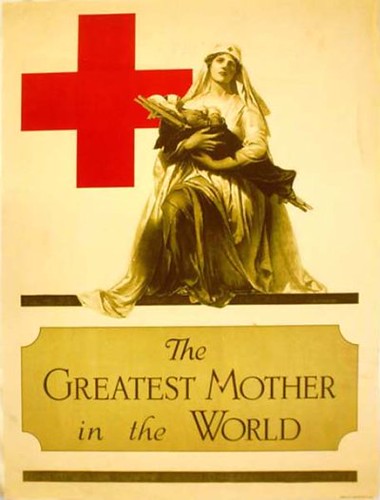As part of the ongoing exhibit of posters in Special Collections for Veterans Day, the students who created the exhibits also created entries for this blog. We will be posting these over the rest of the month of November.
1992.004.5.65-66
Title: The Greatest Mother in the World. Second War Fund.
Artist/ Publisher: A.E. Foringer
Date: 1918
Country of Origin: American
Dimensions: 69.8 x 51.9 cm
The Red Cross is an international relief program that aids millions of people worldwide during wartime, emergencies, and natural disasters. When war broke out in Europe in 1914, surgeons and volunteers were sent to the front lines immediately to help. However, as World War I dragged on into an armistice, the need for more supplies and volunteers to aid in the wake of the mounting desolation of death and disease grew rapidly. Calling to the families left on the home front became the only plausible way to deal with the ever growing need. Propaganda for the Red Cross developed quickly in Europe and America, asking not only for money and supplies, but willing woman to join the cause as well.
One of the most renowned Red Cross propaganda posters to come out of World War I was created by an American illustrator and engraver named Alonzo Foringer. The Greatest Mother in the World, as it is titled, was published in 1918, a year after America joined the conflict and also the final year of the war. The year is significant because, by that time, the war effort seemed futile to numerous people. So many young men had died with really nothing to show for it. The hopeful innocence of a short, easy war was lost, along with millions of lives. But even so, the war raged on and support was still needed by those at home. The poster was one last mournful plea for help.
The poster depicts a larger than life Red Cross Nurse cradling a small wounded soldier, who has been immobilized by a stretcher. The nurse’s gown flows gracefully over her body while she serenely gazes upwards. The viewer is immediately reminded of the classical allegory of the Pieta: mother Mary embracing the dead body of her only Son. The allusion gives the title of the work an empowering meaning to be read by the audience in comparing Mother Mary to a Red Cross nurse. By becoming a Red Cross nurse or supporting the cause, we become elevated to the level of the greatest mother in the world, the mother of Christ himself. By giving back, we perform our Christian duty.
The Christian symbolism would have been extremely compelling to the desperate, war torn audience, however the poster’s style proves an even deeper message. The first image that catches the viewer’s eye is the colossal Red Cross. She is masculinized by her size and stoic demeanor, but retains delicate feminine features. Like Mary, she is the ideal combination of strength and beauty. She embodies America’s supremacy of protection and power without alluding to the actual fighting and loss going on during war. After engaging with The Greatest Mother, the viewer identifies the diminutive soldier in her arms. In Red Cross propaganda, wounded soldiers are typically pictured as helpless victims of wartime tragedy. In this example, the soldier is bandaged and laid across a stretcher. Like Christ of the Pieta, he is as tiny as a child, with his arms crossed over his chest as if he had just passed on into the afterlife. The image created a sympathetic appeal for viewers, especially women, by representing the anonymous wounded soldier as weak and in need of care. Women at home saw themselves stepping in to the role of maternal nurse to help the ailing men. Sentimentalizing and creating anonymity in depictions of the wounded soldiers hid the horrible situation that war really was. Overall, the compelling symbolism of The Greatest Mother in the World brought a glimmer of restored hope to hopeless war.
Publication History
Wake up, America! : World War I and the American Poster by Walton Rawls.
What did you do in the war, Daddy? : A Visual History of Propaganda Posters by Peter Stanley.
The Greatest Mother in the World – pamphlet by Francis Bennett/ American Red Cross (WWI B462)
Related Works
Within Special Collections
Title: What Can You Do? Join Our Red Cross. Membership Including Red Cross Magazine $2.00. No Field Service Required.
Artist/ Publisher: Unknown
Date: 1910-1920
Country of Origin: American
Dimensions: 106.2 x 71.2 cm
1992.004.5.81
Title: December 16th to 23d. Where Columbia Sets Her Name, Let Every One Follow Her. Red Cross Christmas Roll Call.
Artist/ Publisher: Unknown/ Edwin Howland, Blashfield
Date: 1918
Country of Origin: American
Dimensions: 70.9 x 47.8 cm
Title: Help the Red Cross
Artist/ Publisher: Herman Roeg
Date: 1910-1920
Country of Origin: American
Dimensions: 71 x 48.3 cm
1992.004.5.23
Title: “Inasmuch as ye have done it unto one of the least of these.” Help Your Red Cross.
Artist/ Publisher: Hubert Chapin/ Latham Litho. and Ptg. Co., Brooklyn, New York.
Date: 1910-1920
Country of Origin: American
Dimensions: 56 x 35.7 cm
1992.004.5.4
Title: We Need You
Artist/ Publisher: Albert Sterner
Date: 1918
Country of Origin: American
Dimensions: 101.6 x 77.47 cm
Outside of Special Collections
Title: Belgian Red Cross
Artist/ Publisher: Charles Buchel
Date: 1914-1918
Country of Origin: British
Title: If I Fail He Dies
Artist/ Publisher: S.A. Iciek and A.G. McCoy
Date: 1918
Country of Origin: American
Title: In the Name of Mercy Give!
Artist/ Publisher: Albert Herter
Date: 1917
Country of Origin: Unknown
Title: What are you doing to help? Join your American Red Cross
Artist/ Publisher: Gordon Grant
Date: 1917
Country of Origin: American
— Guest post by Tiffany Sides


